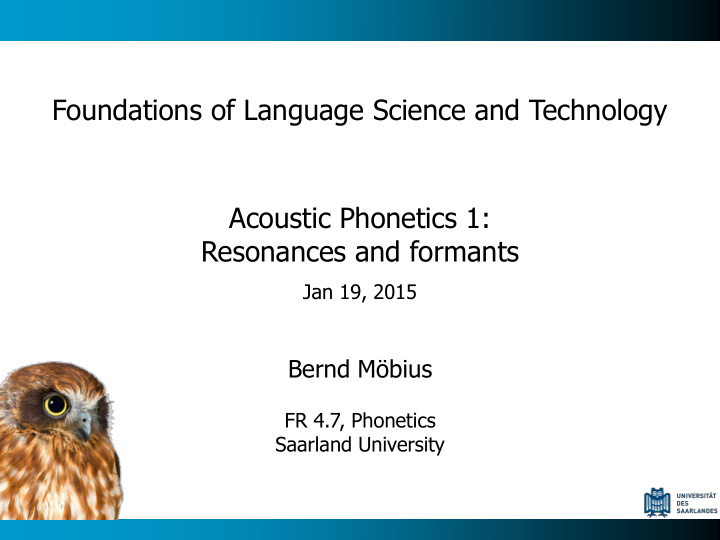



Foundations of Language Science and Technology Acoustic Phonetics 1: Resonances and formants Jan 19, 2015 Bernd Möbius FR 4.7, Phonetics Saarland University
Speech waveforms and spectrograms A f t
Formants � Spectral peaks, energy maxima: formants � Formants emerge as a consequence of selective reinforcement of certain frequency ranges, corresponding to resonance characteristisc of the vocal tract. � Distinguishing between voice source (periodic, stochastic, transient, mixed excitation) and sound formation in the vocal tract motivates the source-and-filter model of speech production. � References: � Gunnar Fant (1960): Acoustic theory of speech production � Gerold Ungeheuer (1962): Elemente einer akustischen Theorie der Vokalartikulation
Source-filter model of speech production
Vocal tract as acoustic filter � Vocal tract geometry, determined by tongue position, jaw opening, and lip protrusion
Vocal tract: acoustic tube model [Clark et al., 2007a, p.241]
Vocal tract: acoustic tube model � Acoustic signals evolve as longitudinal waves in vocal tract � 2 physical parameters of acoustic waves � sound pressure p : change of air pressure evoked by sound at place of measurement � sound velocity v : speed of air particles caused by sound event (note: this is not the speed of sound c !) � Perfect reflexion at sound-hard (lossless) walls of tube � v = 0 at place of reflexion � (Lossy) reflexion at sound-soft transition from vocal tract to free acoustic field (i.e. from lips to air) � p = 0 at place of radiation
Sound pressure waves in vocal tract [Hess, ms.]
Computing formant frequencies � Resonance frequencies of neutral vocal tract computed as speed of sound divided by wave length: f i = c / λ i � Frequencies of resonances/formants: F1 = 340 / (4 * 0.17) = 340 / 0.68 = 500 Hz F2 = 340 / (4/3 * 0.17) = 3 * 340 / (4 * 0.17) = 1500 Hz F3 = 340 / (4/5 * 0.17) = 5 * 340 / (4 * 0.17) = 2500 Hz � Distribution of formant frequencies in neutral vocal tract corresponds to formants of central vowel [ ǝ ] � Simple tube model, with constant area, is inadequate for computing formants of other vowels (cf. acoustic theory of vowel articulation [Ungeheuer 1962])
Tube model with variable area [Clark et al., 2007a, p.246]
Resonances: standing waves parameter: v [Johnson, 1997, p.99]
Standing waves: interpretation � interpretation of the graphical representation of standing waves in idealized vocal tract (neutral configuration, see previous figure): � first 4 formants displayed (F – F ) � in tube model and in vocal tract � places of maximum sound velocity (sound velocity nodes, V ) � places of maximum sound pressure (wave maxima, "antinodes") � localization of V in vocal tract
Dynamic area changes � resonances of vocal tract with variable area cannot be straightforwardly visualized as in the neutral tube model � local area changes affect frequencies of resonances, depending on energy distribution of standing wave in tube along longitudinal axis ("z-axis") � e.g., constriction at lip end of tube has same effect as constriction at glottis end: lower resonance frequency � acoustic vowel system can be interpreted as representing geometrical changes with respect to neutral tube geometry and resulting changes of resonance frequencies away from neutral values � acoustic theory of vowel articulation [Ungeheuer (1962)]
Acoustic theory of vowel articulation
Vowels (IPA) F2 F1
Vowels (German [Pompino-Marschall, 1995] )
Vowels (German [Möbius, 2001] )
Vowels (German, F1/F2/F3 [Möbius, 2001] )
Vowels (Am. English [Peterson and Barney, 1952] )
Vowels (German [Möbius] )
Vowels (German [Möbius] )
Vowels (German [Möbius] )
Vocal tract vs. lossless tube � losses in the vocal tract caused by � friction between air particles � vibration of vocal tract walls � viscosity of vocal tract tissue � radiation of sound energy into free acoustic field � lossy vibrations are damped exponentially � spectral equivalent of damping: bandwidth � defined as frequency range comprising 50% of power � corresponding to decrease of amplitude by 3 dB (or 0.707*A) � sound energy expressed in [dB] � sound energy is proportional to square of amplitude � 50% of power = energy maximum minus 3 dB � 0.5 * power = 0.5 * amplitude = 0.707 * amplitude
Resonance response Formant parameters: frequency, amplitude, bandwidth
Speech waveforms and spectrograms B3=bandwidth(F3) B2=bandwidth(F2) B1=bandwidth(F1)
Thanks!
Recommend
More recommend